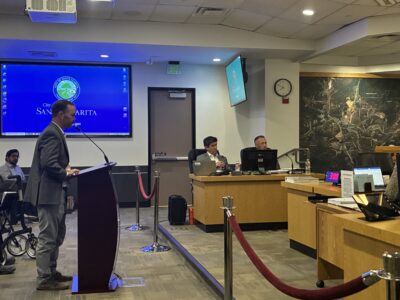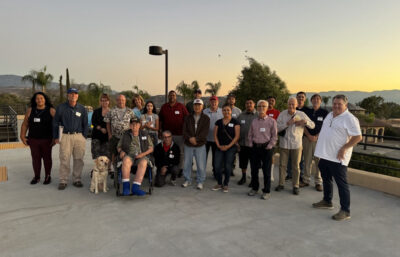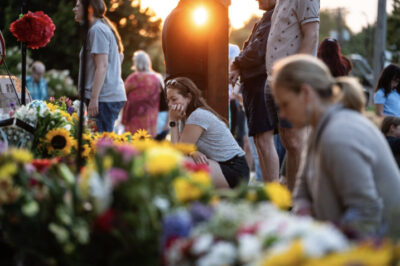
Friends Jocelyn Bonilla and Danielle Dobrow have spent many of their Sundays of the past year at the Castaic Animal Care Center getting to know the dogs there, running around with them, taking pictures and video of them, and posting about them on social media with hopes of getting them adopted.
According to Paul Maradiaga, manager of the Castaic Animal Care Center, the two women have been instrumental in finding homes for many of the animals that have come through the shelter.
“They have definitely made an impact for our care center,” he said. “The reason why is that they promote our animals on social media — how an animal interacts with a person, if they know any tricks. Because people come to the care center, they just see a dog through the kennels. But that’s not enough.”
Valencia resident Bonilla, 37, and Dobrow, 40, who also lives in Valencia, drive out to the Castaic Animal Care Center almost every Sunday. They said they’ve lived with pets in their lives for as far back as they can remember.
Dobrow said she’s had all kinds of animals over the years — fish, turtles and, of course, dogs. Bonilla spoke about her 3-year-old Bernese mountain dog named Max, who she got when he was a puppy.
“My connection to him and my love for him just made me want to do more for other dogs, especially as I became more aware of the shelter crisis,” Bonilla said. “That’s what prompted me to volunteer.”

It was through her volunteer work, she said, that she met and rescued her dog Nico, who had been adopted twice and returned twice. Nico was scheduled to be euthanized. Bonilla couldn’t let that happen. She rescued him and he’s been such a great dog who loves to run, loves to play and loves to hike, she said.
Bonilla started volunteering at the shelter a little over a year ago. Dobrow started about two years ago. Before they began making videos, they cleaned up after the animals, washed them, fed them and played with them. And they got attached to them and found it difficult to lose them. They had to do something to find them permanent homes. If only people could see that these animals could be so loving and playful.
Both Bonilla and Dobrow felt videos and pictures of the dogs outside their kennels, images they could spread on social media, might encourage people to come in and adopt. Getting people to the shelter, however, was going to be a challenge.
Getting people to see the dogs as they are, Dobrow said, was yet another obstacle, adding that, often, people come and see dogs in their kennels, barking, jumping — perhaps not so playful and friendly — and that can be a turn-off.

One shelter volunteer, Lynn Wright, spoke in a January interview about the very idea of dogs being cooped up and how that affects their behavior. He set a personal goal to keep them active by taking out as many dogs as he can, but, he said, it’s a challenge.
“We’re trying to take out as many dogs as we can,” Wright said. “These dogs are in these cages 24 hours a day. The only time they come out is for 15 or 20 minutes.”
On a typical day that Wright volunteers, he’ll spend two to three hours walking dogs and playing with them. On that day in January, he referred to a clipboard with a list of names of about 40 dogs in the kennel, suggesting that for the two to three hours he was going to be there, not all of the dogs were going to get out.

In other words, he said, the more volunteers who can come to the shelter and spend that kind of time with the animals, the better. Adoption, he added, is obviously the goal.
“We’ve learned firsthand that what you see in the kennel is not always what you get outside in the play yards,” Bonilla said. “Oftentimes, people will see a barking dog, a jumping dog, but once you pull them out, you’ll see a completely different demeanor. You’ll see how playful they can be or how reserved they can be.”
And while Bonilla and Dobrow are getting the dogs out to play, they’re also capturing that time on video and in pictures so people on social media can see the dogs’ true personalities.

Dobrow discussed the videomaking process she and Bonilla employ.
“When Joss and I go into the play yard with the dogs, we take turns,” she said. “So, say we’re working with one dog — I’ll video her working on obedience training, and then she’ll video me, maybe brushing a dog or petting a dog.”
Valencia resident Erica Sellers regularly visits the Castaic Animal Care Center, and she also posts about animals on social media, often sharing with her network of people the videos that Bonilla and Dobrow make to get the animals adopted. She said Bonilla and Dobrow have played a crucial role in finding homes for dogs in the past year and a half.
“They have a unique system set up where every Sunday they carpool down to the shelter, play and work on basic skills with the dogs, and film each so that there’s content for the week,” Sellers wrote in an email. “This helps the public know who is currently in the shelter and what kind of skills and traits the dogs have.”

The videos typically provide dogs’ names, breeds, ages, and they’ll show the dogs performing tricks and playing with Bonilla and Dobrow. In one video, Flynn R., a 5-year-old, 68-pound male pittie mix, shows off his playful side as he sits on command and fetches a tennis ball, revealing a personality that may not come through when he’s in a kennel.
As for how many animals Bonilla and Dobrow have helped get adopted, Sellers said it was difficult to quantify, adding that once they’ve made and posted their videos, various networkers will share them across different social media platforms.
“Danielle and Jocelyn have a way of capturing the shelter dogs’ potential in videos,” Sellers said, “and the dogs always look so happy when they’re out with them. They have helped put thousands of eyes on these dogs that otherwise might never be seen.”
She added that their passion for the animals and for the shelter’s commitment to find homes for the animals is infectious.
Maradiaga said the shelter frequently receives emails from people interested in adopting dogs after seeing the videos Bonilla and Dobrow have created.
“They’ll write in and say, ‘Hey, I saw this on social media, can I get a little bit more information?’” Maradiaga said. “Or, if there’s a specific dog that we’re trying to push out, they (Bonilla and Dobrow) immediately advise that person (someone who showed interest online), ‘Hey, please contact the management team, see if you can coordinate a time to meet with the animal.’ We’re very appreciative of Jocelyn and Danielle.”
Each day Bonilla and Dobrow go to the shelter, they try to video at least two to three dogs. And while they didn’t have a count of all the dogs they’ve promoted on social media and possibly saved, both agreed that they’ve worked with hundreds of dogs.

Maradiaga also couldn’t quantify their results. But he was confident that since they started making their videos, he’s no doubt seen more adoptions.
But adoption is one thing — finding dogs permanent homes is what Bonilla, Dobrow and Maradiaga said is essential.
One thing Bonilla and Dobrow suggested is that potential adopters do their homework before bringing a dog home. They also emphasized the importance of giving dogs time to adjust to new surroundings.
“Oftentimes,” Bonilla said, “people fail to give dogs the proper decompression time, and any little bad behavior that they see, they immediately return the dogs, which was the case with Nico. It’s great to want to help, but make sure you do your research, know the breed and know your own lifestyle. Make sure that breed fits your lifestyle, so that down the road, this will be a forever-adoption and not a dog that ends up being returned to the shelter and eventually ends up in a 72-hour list and potentially euthanized.”
Maradiaga praised the work of Bonilla and Dobrow, saying he holds it in the highest regard.
In addition to taking the dogs out and promoting them on social media, he shared instances in which the two women played a key role in keeping the shelter informed about the animals.
“They don’t hesitate to engage with us,” Maradiaga said. “They’ll say, ‘What’s the status on this dog?’ or ‘We’re moving forward on networking this animal, can you give us more details?’ Or they share how they strongly feel about a specific dog, which is very important to us.”
Maradiaga said that Bonilla and Dobrow will spend time with a dog and might notice that the listed behavior is inaccurate. They’ll request a reevaluation of the animal, and that can be the difference between a dog getting adopted and not getting adopted.
A dog listed as not getting along with other animals, for example, might struggle to find a home, since many potential adopters could already have pets and may worry about compatibility. According to Maradiaga, Bonilla and Dobrow spend time getting to know each animal so they can give potential adopters a better understanding of the animal’s personality and needs.
“That’s because of their efforts in providing enrichment,” Maradiaga said, “getting animals out of the kennels.”
Almost every Sunday, while many people are winding down their weekends, Bonilla and Dobrow are out at the Castaic Animal Care Center, giving animals a second chance — not just at being seen, but at being understood.

What started as a love for their own pets has grown into a mission of compassion, captured in playful videos and heartfelt moments that travel across social media and into the lives of countless families. For these two friends, Sundays aren’t just about volunteering — they’re about saving lives, one wagging tail at a time.
For more information about the Castaic Animal Care Center, go to bit.ly/4hhvWKT. Additionally, the shelter will be hosting an adoption event from 11 a.m. to 3:30 p.m. on Sunday, June 8.
Know any unsung heroes or people in the SCV with an interesting life story to tell? Email [email protected].










